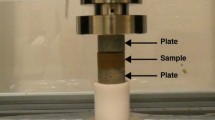Abstract
The physical and mechanical properties of mechanically-pressed clay building units, whether solid or perforated, are largely improved by deairing. Die-laminations are lessened. Moreover, deairing provides always units of developed strengths. Prepugging, using birollers machinery, proves effective only in rubbing and well mixing the clay mixes before extrusion.
In solid machine-pressed building units the direction of extrusion shows the relatively highest value when tested for strength. On the other hand, for the perforated equivalents, this depends, among other factors, on the load-bearing area to which the pressure is applied. However, the size and shape of perforations through the perforated units largely affect the mechanical properties of the latter.
Résumé
Facteurs qui affectent les propriétés des unités de construction mécaniquement formées.—On a obtenu par façonnage mécanique sous pression des briquettes perforées à partir d'un mélange sélectionné de 70% d'argile et de 30% de sable. La désaération du mélange extrudé joue, un rôle important dans la diminution des pores et dans l'accroissement de la résistance des échantillons cuits. En outre, la désaération contribue à réduire les laminations que subit le produit au cours de l'extrusion.
La désaération, ou le recorroyage sous vide du mélange extrudé, ont un effet marquant sur les propriétés dues au séchage et à la cuisson des briquettes, et contribuent à éliminer les défauts de formage et à améliorer les propriétés physiques requises. Par contre le précorroyage par passage du mélange entre deux cylindres, n'a pas d'effet sensible sur ces propriétés, quoiqu'il facilite nettement le pétrissage et le malaxage de l'argile.
On a constaté que la résistance aux charges des échantillons cuits dépend principalement de la surface effective de chargement et de la direction de l'extrusion, comme de la dimension et de la forme des perforations que comportent les briquettes.
Similar content being viewed by others
References
Gad, G.M., andAbdel Maksoud, M.—Constitution and suitability of Kharga clays. J. Chem., U.A.R., vol. 9, 1966, p. 235.
Gad, G.M., andAbdel Maksoud, M.—The suitability of Kharga clays for the production of mechanically formed building units. J. Chem. U.A.R., vol. 12, no 3 (1969).
Prestern, A., andSteele, J.R.—Effect of additional pugging on clays or shales, Bull. Am. Ceram. Soc., 1953, p. 215.
Clews, F.H.—Practical experiences in the deairing of heavy clay goods. A report on a questionnaire, Trans. Brit. Ceram. Soc., no 6, 1938, p. 232.
McBurney, J.W., andJohnson, P.V.—Durability of deaired brick, J. Am. Ceram. Soc., vol. 39, no 5, 1956, p. 159.
Loveyjoy, E., andCovan, H.E.—A laboratory equipment for stiff mud tests including exhaustion of the air. J. Am. Ceram. Soc., vol. 14, 1931, p. 533.
Gilbert W.—Some problems of manufacture by wire-cut process, Trans. Brit. Ceram. Soc., vol. 58, 1959, p. 645.
KarlHändle & Söhne.—Labor-Vakuum-Aggregat, PZVM, 8 A., Händle/Münhlacker, Germany (Catalogue).
Conference of Standardization of Measurements —Standard methods of physical and chemical tests for all kinds of bricks, The Egyptian Standard Specifications, no 48, 1960.
McBurney, J.W.—The compressive and transverse strength of brick., J. Am. Ceram. Soc., vol. 12, 1929, p. 244.
Timoshenko S.—Strength of materials, D. Van Nostrand Co., Inc., New York Part I, 1955, p. 258.
Author information
Authors and Affiliations
Rights and permissions
About this article
Cite this article
Maksoud, M.A., Gad, G. Factors affecting properties of mechanically-formed building units. Mat. Constr. 4, 115–122 (1971). https://doi.org/10.1007/BF02473966
Issue Date:
DOI: https://doi.org/10.1007/BF02473966




